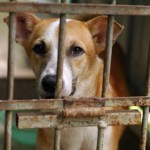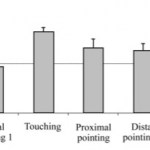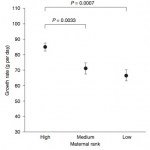genetics
The journal Nature has selected optogenetics as its "Method of the Year", and it certainly is cool. But what really impressed me is this video, which explains the technique. It doesn't talk down to the viewer, it doesn't overhype, it doesn't rely on telling you how it will cure cancer (it doesn't), it just explains and shows how you can use light pulses to trigger changes in electrical activity in cells. Well done!
My direct experience with prokaryotes is sadly limited — while our entire lives and environment are profoundly shaped by the activity of bacteria, we rarely actually see the little guys. The closest I've come was some years ago, when I was doing work on grasshopper embryos, and sterile technique was a pressing concern. The work was done under a hood that we regularly hosed down with 95% alcohol, we'd extract embryos from their eggs, and we'd keep them alive for hours to days in tissue culture medium — a rich soup of nutrients that was also a ripe environment for bacterial growth. I was…
Mary Carmichael has a great video (and associated post) about the rise of genetic denialism--ridiculous arguments that 'genes don't cause disease.'* Carmichael offers two reasons why the argument is flawed; I'll offer a third in a bit, but I do want to note one minor point of disagreement with Carmichael.
If you go to roughly the ten minute mark, Carmichael has a summary slide that lists several phenomena that could account for the 'missing heritability'--the observation that currently identified genomic variation can't account for much the expected heritability as determined by various…
To paraphrase Mark Twain, biological understanding may not repeat itself, but it does rhyme. There's a recent commentary, "The Great DNA Data Deficit: Are Genes for Disease a Mirage?", from the Bioscience Resource Project which, if Twitter is any guide (and how could Twitter possibly not be?), is leading to some angry rebuttals, even as I write this. The piece discusses Genome Wide Association Studies ('GWAS'), and argues that GWAS is overhyped in that many common diseases have a very limited genetic basis. Before I deal with the piece (which has good and bad points), I would note that I'm…
Ah, Thanksgiving. A day full of turkey, cranberries, pie, and, of course, SCIENCE! After you fill your stomach with gravy and stuffing, stuff your mind with all this great Thanksgiving science.
What's any good Thanksgiving feast without some turkey? Emily Anthes of Wonderland starts the meal off with an offering of thanks for the turkey's contribution to cancer research. But wait! That's not all the science of turkeyhood to be consumed. Feast your minds on my contribution at the Scientific American Guest Blog: the social-cognitive abilities of turkeys. And in case you're feeling particularly…
Last week, the U.S. Department of Justice filed an amicus brief which argued that naturally-occurring DNA sequences can't be patented:
Reversing a longstanding policy, the federal government said on Friday that human and other genes should not be eligible for patents because they are part of nature....
"We acknowledge that this conclusion is contrary to the longstanding practice of the Patent and Trademark Office, as well as the practice of the National Institutes of Health and other government agencies that have in the past sought and obtained patents for isolated genomic DNA," the brief…
A problem in genome-wide association studies ("GWAS") is the"missing heritability" issue--identified genetic variation can only account for a small fraction of the estimated genetic contribution to variation in that trait. Razib has a good roundup of several explanations (and I added some speculation about nearly-neutral mutations).
GWAS also have problems accurately characterizing the trait. For example, not all heart diseases (note the plural) are alike, so we have to be certain that we accurately assess the trait of interest. But what is very rarely discussed is the environmental…
Human infants require more care than they should, if we form our expectations based on closely related species (apes, and more generally, Old World simian primates). It has been said that humans are born three months early. This is not accurate. It was thought that our body size predicted a 12 month gestation, and some suggested that Neanderthals would have had such, but this research conclusion has been set aside based on new analysis. But it is still true that developmentally, human children do not reach a stage of development that allows some degree of self care for a very long time…
And by hot, I mean employable. I'll get to that in a bit, but I first want to relate some history. Back when I was a wee lil' Mad Biologist, and molecular population genetics was in its infancy, there was a brief period where people had to be convinced that this stuff was useful (it was). Then it became fashionable, and the 'early adopters'--people who were regularly using PCR and clone-based sequencing (followed by S35 sequencing)--became hot intellectual commodities for about five years. Then the field became crowded, but 'good' molecular population geneticists (whatever 'good' means)…
Here at The Thoughtful Animal, we are conducting series of seven-question interviews with people who are doing or have done animal research of all kinds - biomedical, behavioral, cognitive, and so forth. Interested in how animal research is conducted, or why animal research is important? Think you might want to do some animal research of your own someday? This is the interview series for you.
Andrew Thaler (twitter, blog) is pursuing a doctorate in the marine biology at the Duke University Marine Lab. He is especially interested in population genetics in hydrothermal vent communities. He is…
At least one dog can be found in forty percent of US households, and forty percent of those owners allow their dogs to sleep on their beds. To put this in perspective, in a family with five children, two of them can be expected to become dog owners, and one of them will probably allow the dog to sleep on his or her bed. In an undergraduate lecture class of two hundred, eighty of those students come from homes with at least one pet dog. So as you might expect, dogs are a big business! In 2007, the pet industry was worth about $40 billion in the US, with dogs responsible for the largest share…
What a curious paper — it's fine research, and it's a useful dollop of data, but it's simultaneously so 21st century and on the edge of being completely trivial. It's like a tiny shard of the future whipping by on its way to quaintness.
Researchers have for the first time sequenced the genome of an Irishman, a fellow confirmed to be the product of at least 3 generations of fully Irish ancestors.
It's a good piece of work, another piece in the puzzle of human genomics, but it's also a little bit odd. I'm always excited to see another organism's genome sequenced, the first marsupial, the first…
For today's dose of monday pet blogging, head on over to a piece that I wrote for Scientific American that went up today. I used the invitation as an opportunity to a dig a little deeper into the story of Belyaev and his domesticated silver foxes (I previously wrote about them, here and here)
Dogs are pretty smart. They can have huge vocabularies, they can infer meaning in the growls of other dogs, and they can effortlessly figure out if other dogs want to play or fight with them. But their intelligence might be limited to the social domain; indeed, while they outperform chimpanzees in social tasks, chimpanzees outperform them in many other tasks. And they might have developed their impressive social skills as merely an accident of natural and artificial selection.
Previous research has shown that dogs can use lots of different forms of human communicative signals to find food,…
One of the mysteries of genome-wide association studies ("GWAS") is the problem of 'missing heritability': quantitative genetics indicates that a trait (e.g., height, heart disease) has a significant genetic component, but the genetic variation we can link to that trait only explains a small amount of the suggested heritability. Christophe Lambert describes why he thinks GWAS hasn't had that much success so far:
One major limitation is that the microarrays used in most major GWAS efforts to date employ common genetic variants originally identified in a rather small number of presumably…
Figure 1: A mother hyena with her cubs.
Early developmental experiences can have significant implications for the growth, behavior, survival, and reproductive success of an individual. In many species, one of the most important factors that affects an individual's early development is the maternal environment. However, mothers not only provide an environment for their offspring, but also half of their genes, making it difficult to separate the effects of nature and nurture when investigating developmental outcomes in the offspring. Moreover, because male mammals usually disperse from the…
Thanks to BleachGate, this is probably the first time many of you all in the Skeptical Community have heard about Crohns Disease (SPOILER: kid with Chrons gets booted from a 'support' forum for speaking out against woo-'treatments').
Crohns is an inflammatory bowl disease (IBD), where your guts do fun things like shrink until your bowls are obstructed, or your body decides you need more passages out of your intestines (Google 'fistula'. I dare you.), and some times you just good-old-fashioned poop blood. So, dont confuse IBD with IBS, and dont get me started on IBS.
Crohns is the usual grab-…
One of the subjects developmental biologists are interested in is the development of pattern. There are the obvious externally visible patterns — the stripes of a zebra, leopard spots, the ordered ranks of your teeth, etc., etc., etc. — and in fact, just about everything about most multicellular organisms is about pattern. Without it, you'd be an amorphous blob.
But there are also invisible patterns that you don't normally see that are aspects of the process of assembly, the little seams and welds where disparate pieces of the organism are stitched together during development. The best known…
Ed Yong recently published a post called "On the origin of science writers" asking that science writers (anyone who regularly writes about science) tell the story of how they got started. The idea is to establish a resource for future writers. I joined the thread and have reprinted it here.
As far back as I can remember I loved to read and I loved the wilderness. In fact my favorite times were reading in the wilderness, preferably in a tree near our mountain cabin, high enough where my brothers could not reach me with stones or snowballs.
I did not think much about being a writer myself until…
Spiegel has a wonderful interview with Venter. The more I hear from Venter, the more I like him; he's very much a no-BS sort of fellow. He's the guy who really drove the human genome project to completion, and he's entirely open about explaining that its medical significance was grossly overstated.
SPIEGEL: So the significance of the genome isn't so great after all?
Venter: Not at all. I can tell you from my own experience. I put my own genome on the Internet. People had the notion this was the scariest thing out there. But what happened? Nothing.
There really was a lot of hysteria in the…




